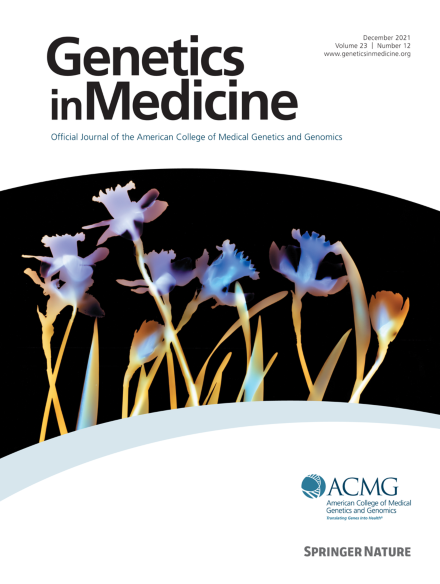A systematic framework for selecting gene-condition pairs for inclusion in newborn sequencing panels: Early Check implementation
IF 6.6
1区 医学
Q1 GENETICS & HEREDITY
引用次数: 0
Abstract
Purpose
Research is underway worldwide to investigate the feasibility, acceptability, and utility of sequencing-based newborn screening. Different methods have been used to select gene-condition pairs for screening, leading to highly inconsistent gene lists across studies.
Methods
Early Check developed and utilized actionability-based frameworks for evaluating gene-condition pairs for inclusion in newborn panels (panel 1-high actionability, panel 2-possible actionability). A previously developed framework, the Age-based Semi Quantitative Metric (ASQM), was adapted. Increasing ASQM scores, with a maximum of 15, suggest greater actionability. Wilcoxon tests were performed to compare panel 1 gene-condition pairs on the Recommended Uniform Screening Panel (RUSP) with non-RUSP pairs.
Results
In our first round of assessment, Early Check identified 178 gene-condition pairs for inclusion in panel 1 and 29 for panel 2. Median ASQM scores of RUSP conditions on panel 1 was 12 (range 4 to 15) and non-RUSP was 13 (range 9 to 15). Median scores for panel 2 was 10 (range 6 to 14).
Conclusion
The Early Check frameworks provide a transparent, semiquantitative, and reproducible methodology for selecting gene-condition pairs for newborn screening sequencing pilot studies that may inform future integration of genomic sequencing into population-level newborn screening. Collaborative efforts among newborn sequencing studies to establish shared criteria is needed to enhance cross-study comparisons.
用于选择基因条件对以纳入新生儿测序面板的系统框架:早期检查实施。
目的全球正在开展研究,调查基于测序的新生儿筛查的可行性、可接受性和实用性。筛选基因条件对的方法各不相同,导致不同研究的基因列表极不一致:早期检查开发并使用了基于可操作性的框架,用于评估基因条件对是否可纳入新生儿筛查(面板 1 - 高可操作性,面板 2 - 可能的可操作性)。对之前开发的基于年龄的半定量指标(ASQM)框架进行了调整。ASQM 分数越高(最高为 15 分),表明可操作性越强。通过 Wilcoxon 检验对推荐统一筛查组(RUSP)中的第一组基因条件对与非推荐统一筛查组基因条件对进行了比较:结果:在第一轮评估中,Early Check 确定了 178 对基因条件对可纳入面板 1,29 对可纳入面板 2。面板 1 中 RUSP 条件的 ASQM 分值中位数为 12(范围在 4 到 15 之间),非 RUSP 为 13(范围在 9 到 15 之间)。小组 2 的得分中位数为 10(范围为 6 至 14):早期检查框架提供了一种透明、半定量和可重复的方法,用于为新生儿疾病筛查测序试点研究选择基因-条件对,为将来将基因组测序纳入人群水平的新生儿疾病筛查提供参考。新生儿测序研究之间需要合作建立共同的标准,以加强跨研究比较。
本文章由计算机程序翻译,如有差异,请以英文原文为准。
求助全文
约1分钟内获得全文
求助全文
来源期刊

Genetics in Medicine
医学-遗传学
CiteScore
15.20
自引率
6.80%
发文量
857
审稿时长
1.3 weeks
期刊介绍:
Genetics in Medicine (GIM) is the official journal of the American College of Medical Genetics and Genomics. The journal''s mission is to enhance the knowledge, understanding, and practice of medical genetics and genomics through publications in clinical and laboratory genetics and genomics, including ethical, legal, and social issues as well as public health.
GIM encourages research that combats racism, includes diverse populations and is written by authors from diverse and underrepresented backgrounds.
 求助内容:
求助内容: 应助结果提醒方式:
应助结果提醒方式:


